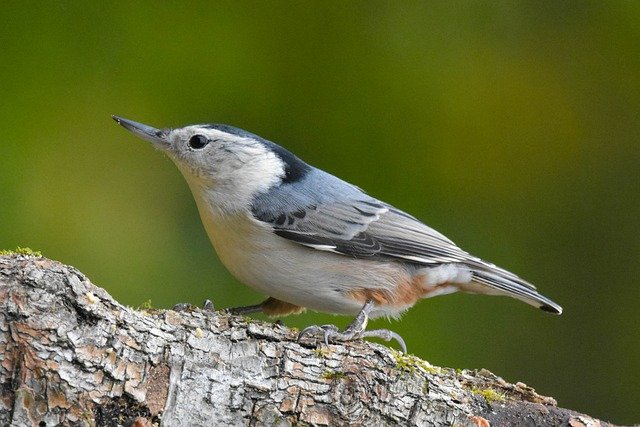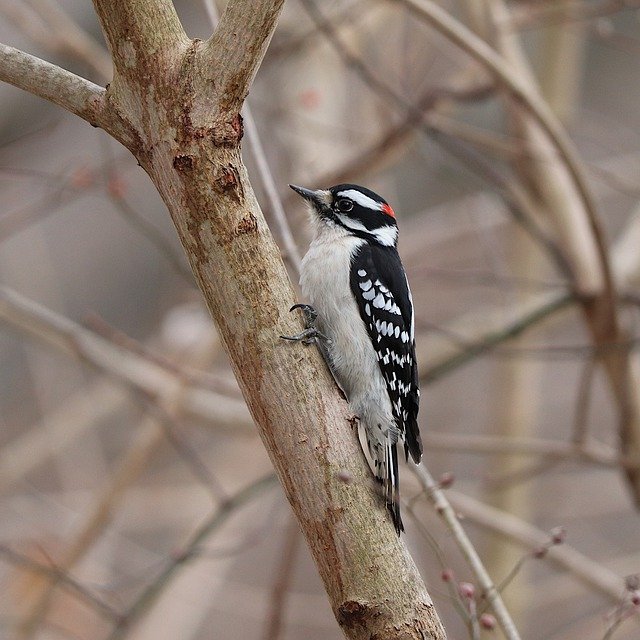White birds aren’t extremely common in New York therefore, in this article I’ve compiled a list of 5 white birds or birds with elements of white on their plumage that you can look out for the next time you go out on a birdwatching adventure.
- Black Capped Chickadee
- White Breasted Nuthatch
- American White Ibis
- Downy Woodpecker
- Snowy Egrets
5 White Birds In New York
1. Black Capped Chickadee (Poecile Atricapillus)

- Size – 10 – 15cm
- Weight – 10 – 12 grams
- Wingspan – 15 – 20cm
Black capped chickadees are recognised by their mostly white plumage from breast to tail with gray wings, black throat and upper head. Females look relatively the same.
Your typical chickadee will spend their time within open woods and forest edge, especially where birches or alders grow. They also avoid coniferous forests.
As for what they eat, it mostly consists of insects, fruits, seeds among other berries. The diet does change based on the weather. large portion of a chickadees diet consists of insects in the summer whilst in winter it tends to be a seed, fruit and vegetable diet that makes up around 50% of these little birds diet.
Black capped chickadees are known to live for around 2 – 3 years in the wild although the longest recorded lifespan is said to be around 11.5 years.
2. White Breasted Nuthatch (Sitta Carolinensis)

- Size – 13 – 14cm
- Weight – 18 – 30 grams
- Wingspan – 20 – 27cm
White breasted nuthatches are recognised by their gray back, wings and the upper head with white breast feathers. Females look the same as the males.
As for where you would find the white breasted nuthatch, it would be around mature woods and woodland edges, where they’re most commonly located by deciduous stands that have maple, hickory, basswood, oak and are even found in some coniferous forests.
They mostly consume nuts, seeds and insects, which can include hazelnuts, sunflower seeds and suet.
As for how long white breasted nuthatches live in the wild, it tends to be around 2 years with the longest lifespan recorded around 12 years.
3. American White Ibis (Eudocimus Albums)

- Size – 53 – 70cm
- Weight – 920 – 970 grams
- Wingspan – 90 – 105cm
The American white ibis is recognised by its white plumage, long neck, long and pointy beak as well as by its pink legs. Females look more or less the same but are slightly smaller with a smaller beak. As for how big their beak can be, it’s normally around 15 – 20cm.
White ibises aren’t commonly located in New York but you may see a few vagrant ones here and there normally around coastal marshes and wetlands where you will often find them feeding in fresh, brackish, and saltwater environments.
As for what they eat it includes aquatic animals such as fish, snails and crayfish. Furthermore, in recent times they’ve even gotten accustomed to eating bread, fast food or pop corn.
These long billed birds are known to live between 16 – 27 years.
4. Downy Woodpecker (Picoides Pubescent)

- Size – 14 – 18cm
- Weight – 20 – 33 grams
- Wingspan – 25 – 31cm
Downy woodpeckers are mostly white and black with the breast white in color and their back and wings a mixture of black and white. The main separation between male and females is that the males have a red spot at the top of their head whilst the females are just white and black.
These woodpeckers spend the majority of their time within forests, woodlots, willows, river groves, orchards and shade trees.
When in these habitats downy woodpeckers will mostly consume black oil sunflower seeds, millet, peanuts, and chunky peanut butter found within feeders and in occasion even consume sugar water from the feeders designed for hummingbirds.
Downy woodpeckers tend to live for around 2 years on average whilst 5 years is on the upper end of their life.
5. Snowy Egret (Egretta Thula)

- Size – 56 – 66cm
- Weight – 350 – 390 grams
- Wingspan – 95 – 105cm
Snowy egrets as their name would suggest are snow white birds with a long neck, black beak, black legs whilst also having a relatively large frame. Besides their sexual organs the only differentiating factors between males and females are that the males are slightly larger.
You’ll find these egrets by mudflats, beaches, and wetlands, but you can also see them forage in wet agricultural fields and along the edges of rivers and lakes. In New York you may spot these snow white birds around Sandy Hook Bay and Raritan Bay.
Snowy egrets eat a variety of foods from fish, insects, crustaceans which includes crabs, crayfish, frogs, snakes, snails, worms, lizards, rodents and more.
These egrets are known to live for around 5 – 6 years in the wild and upwards of 16 years in captivity.
Amhil Khan, a dedicated nature enthusiast and the founder of BirdsOfTheWild.com, is a passionate advocate for the captivating world of avian wonders. With a deep-seated curiosity about the intricate lives of birds, Amhil’s journey began as a fascination and has evolved into a mission to inspire others to appreciate and protect these magnificent creatures.
Amhil’s love for birds led to the creation of Birds of the Wild, a platform where his expertise in ornithology, coupled with his captivating storytelling, provides readers with an immersive and educational experience. Through his lens and words, he captures the essence of birds in their natural habitats, offering a glimpse into their behaviors, migrations, and the ecosystems they inhabit.
